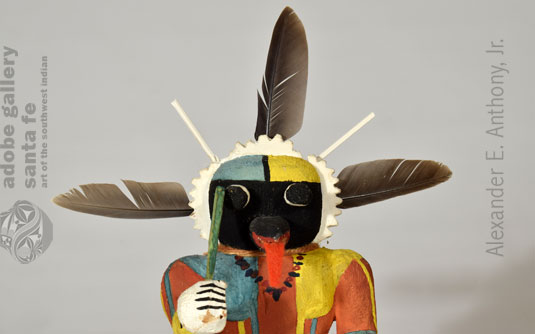Hopi Pueblo Wupamo Katsina - Kachina Doll [SOLD]
+ Add to my watchlist Forward to Friend
- Category: Traditional
- Origin: Hopi Pueblo, Hopituh Shi-nu-mu
- Medium: wood, paint, feathers
- Size: 6-⅞” tall
- Item # C4126C1 SOLD
Wupamo appears on all three mesas as a guard, and the whips that he carries are for use on the unwary. Usually he may be found during the Powamu procession circling out from the sides or swinging in at the rear to spur the laggards. He moves a little more quickly than Wuyak-kuita but just as surely.
On Hopi Pueblo, First Mesa, as one of the Furious Katsinas, he is often led or rather held back by a rope around his waist that is held by a *Koyemsi. He is given to making short furious dashes towards the audience or other katsinas or kiva priests much in the manner of an erratic dog.
In addition to the Powamu he may appear in the Palȍlȍkong or help enforce community work such as spring cleaning.
The Powamu is one of the most important of the Hopi ceremonies. It occurs in February each year in most Hopi villages. The most important aspect of the Powamu ceremony is the anticipation of the coming growing season, with ritual designed to promote fertility and germination.
This representation of Wupamo is short and stocky. Quite often, a carver will carve a doll in the body style of the carver. Perhaps the Hopi who carved this one was short and beefy with wide shoulders. He was beautifully carved and painted with watercolor paints, which suggests he was made in the 1950s. His shoulders and extending down below his pectorals and also extending almost to his waist on the back are painted in alternating colors of blue and yellow. The upper part of the mask repeats the those colors but the paint on the arms reverses their locations. The leg paints follow the style of the shoulder colors.
Condition: this Hopi Pueblo Wupamo Katsina - Kachina Doll is in very good condition with the front of the right foot having been glued in place.
Reference: Kachinas: a Hopi artist’s documentary by Barton Wright with original paintings by Cliff Bahnimptewa
Provenance: from the collection of a family from Santa Fe
*Mudhead - Koyemsi: A Zuni emergence myth tells us that the Zuni began a migration as soon as they entered this world. They first elected leaders for this migration-the son and daughter of the village chief-who went ahead of the others. During the trip, the brother became enamored with his sister and copulated with her. The result of this incestuous relationship was the birth of ten children that night. Nine of the ten were misshapen, impotent, and witless, and they became known as the Koyemshi-also known as the Mudhead. The ten Zuni Mudheads resemble each other but actually are different in their masks and gear.

- Category: Traditional
- Origin: Hopi Pueblo, Hopituh Shi-nu-mu
- Medium: wood, paint, feathers
- Size: 6-⅞” tall
- Item # C4126C1 SOLD



